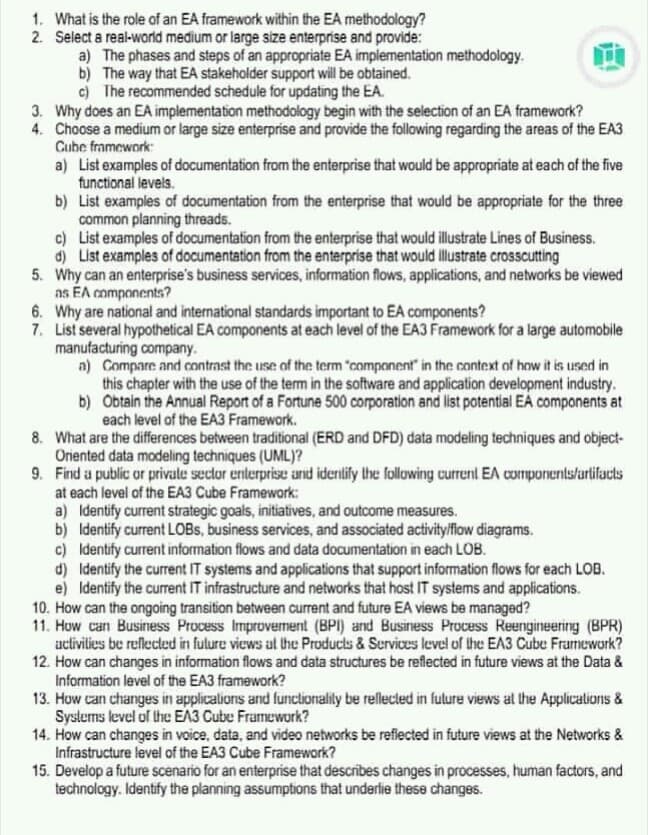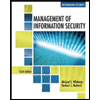What is the role of an EA framework within the EA methodology?
Principles of Information Systems (MindTap Course List)
13th Edition
ISBN:9781305971776
Author:Ralph Stair, George Reynolds
Publisher:Ralph Stair, George Reynolds
Chapter12: System Acquisition And Development
Section: Chapter Questions
Problem 3TA: You and your team have been hired to perform a system investigation for a fast food restaurant that...
Related questions
Question
100%
1. What is the role of an EA framework within the EA methodology?
2. Select a real-world medium or large size enterprise and provide:
a) The phases and steps of an appropriate EA implementation methodology.
b) The way that EA stakeholder support will be obtained.
c) The recommended schedule for updating the EA.
3. Why does an EA implementation methodology begin with the selection of an EA framework?
4. Choose a medium or large size enterprise and provide the following regarding the areas of the EA3
Cube framework:
a) List examples of documentation from the enterprise that would be appropriate at each of the five
functional levels.
b) List examples of documentation from the enterprise that would be appropriate for the three
common planning threads.
c) List examples of documentation from the enterprise that would illustrate Lines of Business.
d) List examples of documentation from the enterprise that would illustrate crosscutting
5. Why can an enterprise’s business services, information flows, applications, and networks be viewed
as EA components?
6. Why are national and international standards important to EA components?
7. List several hypothetical EA components at each level of the EA3 Framework for a large automobile
manufacturing company.
a) Compare and contrast the use of the term “component” in the context of how it is used in
this chapter with the use of the term in the software and application development industry.
b) Obtain the Annual Report of a Fortune 500 corporation and list potential EA components at
each level of the EA3 Framework.
8. What are the differences between traditional (ERD and DFD) data modeling techniques and objectOriented data modeling techniques (UML)?
9. Find a public or private sector enterprise and identify the following current EA components/artifacts
at each level of the EA3 Cube Framework:
a) Identify current strategic goals, initiatives, and outcome measures.
b) Identify current LOBs, business services, and associated activity/flow diagrams.
c) Identify current information flows and data documentation in each LOB.
d) Identify the current IT systems and applications that support information flows for each LOB.
e) Identify the current IT infrastructure and networks that host IT systems and applications.
10. How can the ongoing transition between current and future EA views be managed?
11. How can Business Process Improvement (BPI) and Business Process Reengineering (BPR)
activities be reflected in future views at the Products & Services level of the EA3 Cube Framework?
12. How can changes in information flows and data structures be reflected in future views at the Data &
Information level of the EA3 framework?
13. How can changes in applications and functionality be reflected in future views at the Applications &
Systems level of the EA3 Cube Framework?
14. How can changes in voice, data, and video networks be reflected in future views at the Networks &
Infrastructure level of the EA3 Cube Framework?
15. Develop a future scenario for an enterprise that describes changes in processes, human factors, and
technology. Identify the planning assumptions that underlie these changes.

Transcribed Image Text:1. What is the role of an EA framework within the EA methodology?
2. Select a real-world medium or large size enterprise and provide:
a) The phases and steps of an appropriate EA implementation methodology.
b) The way that EA stakeholder support will be obtained.
c) The recommended schedule for updating the EA.
3. Why does an EA implementation methodology begin with the selection of an EA framework?
4. Choose a medium or large size enterprise and provide the following regarding the areas of the EA3
Cube fromework:
a) List examples of documentation from the enterprise that would be appropriate at each of the five
functional levels.
b) List examples of documentation from the enterprise that would be appropriate for the three
common planning threads.
c) List examples of documentation from the enterprise that would illustrate Lines of Business.
d) List examples of documentation from the enterprise that would illustrate crosscutting
5. Why can an enterprise's business services, information flows, applications, and networks be viewed
as EA components?
6. Why are national and international standards important to EA components?
7. List several hypothetical EA components at each level of the EA3 Framework for a large automobile
manufacturing company.
a) Compare and contrast the use of the term "component in the context of how it is used in
this chapter with the use of the term in the software and application development industry.
b) Obtain the Annual Report of a Fortune 500 corporation and list potential EA components at
each level of the EA3 Framework.
8. What are the differences between traditional (ERD and DFD) data modeling techniques and object-
Oriented data modeling techniques (UML)?
9. Find a public or private sector enterprise and identlify the following current EA componentslartifacts
at each level of the EA3 Cube Framework:
a) Identify current strategic goals, initiatives, and outcome measures.
b) Identify current LOBS, business services, and associated activitylflow diagrams.
c) Identify current information flows and data documentation in each LOB.
d) Identify the current IT systems and applications that support information flows for each LOB.
e) Identify the current IT infrastructure and networks that host IT systems and applications.
10. How can the ongoing transition between current and future EA views be managed?
11. Huw can Business Process Improverment (BPI) and Business Process Reengineering (BPR)
activilies be rellected in fulure views al the Products & Services level of the EA3 Cube Framework?
12. How can changes in information flows and data structures be reflected in future views at the Data &
Information level of the EA3 framework?
13. How can changes in applicalions and funclionality be rellected in fulure views al the Applicalions &
Syslems level of the EA3 Cube Framework?
14. How can changes in voice, data, and video networks be refiected in future views at the Networks &
Infrastructure level of the EA3 Cube Framework?
15. Develop a future scenario for an enterprise that describes changes in processes, human factors, and
technology. Identify the planning assumptions that underlie these changes.
Expert Solution
This question has been solved!
Explore an expertly crafted, step-by-step solution for a thorough understanding of key concepts.
This is a popular solution!
Trending now
This is a popular solution!
Step by step
Solved in 2 steps

Knowledge Booster
Learn more about
Need a deep-dive on the concept behind this application? Look no further. Learn more about this topic, computer-science and related others by exploring similar questions and additional content below.Recommended textbooks for you

Principles of Information Systems (MindTap Course…
Computer Science
ISBN:
9781305971776
Author:
Ralph Stair, George Reynolds
Publisher:
Cengage Learning

Fundamentals of Information Systems
Computer Science
ISBN:
9781337097536
Author:
Ralph Stair, George Reynolds
Publisher:
Cengage Learning

Management Of Information Security
Computer Science
ISBN:
9781337405713
Author:
WHITMAN, Michael.
Publisher:
Cengage Learning,

Principles of Information Systems (MindTap Course…
Computer Science
ISBN:
9781305971776
Author:
Ralph Stair, George Reynolds
Publisher:
Cengage Learning

Fundamentals of Information Systems
Computer Science
ISBN:
9781337097536
Author:
Ralph Stair, George Reynolds
Publisher:
Cengage Learning

Management Of Information Security
Computer Science
ISBN:
9781337405713
Author:
WHITMAN, Michael.
Publisher:
Cengage Learning,